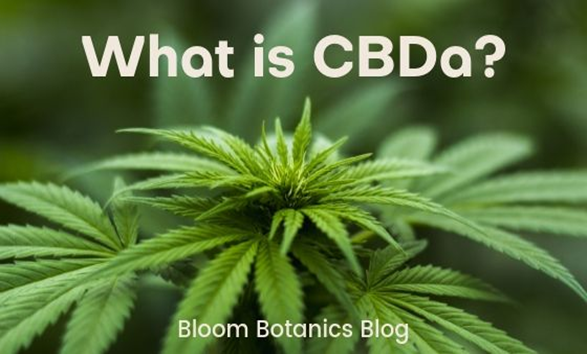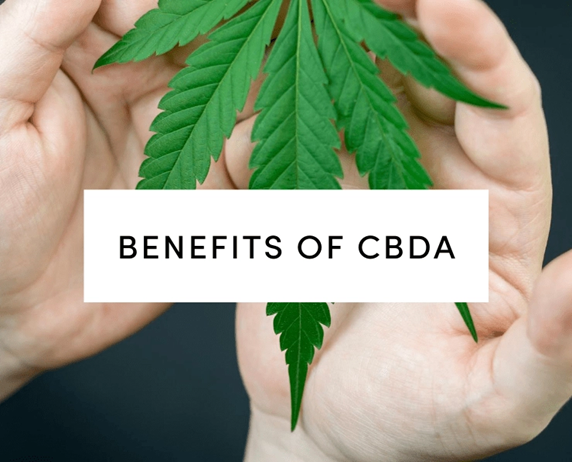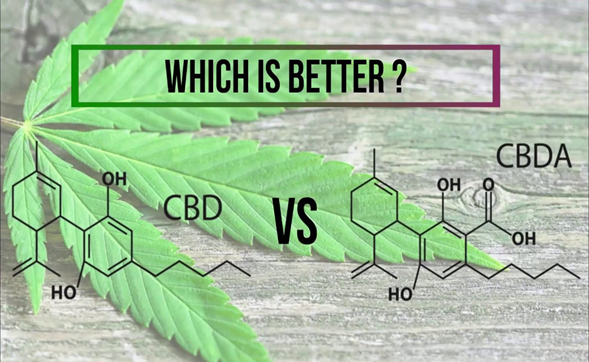If you are a cannabis user, you must be quite familiar with the terms CBD and THC. But have you ever heard of CBDA? This less-popular component is one among the hundreds of other compounds found in the cannabis plant. We all know that CBD, aka cannabinoid, is known for its tremendous health benefits but little do we know that CBDA also plays an important role in it.
CBDA and CBD, two components of the cannabis plant, are almost similar but it is very important to know the key differences between the two that separates CBDA from CBD. Hearing the term CBDA for the first time would raise multiple questions in your mind, the answers of which are well-explained in this comprehensive guide.
What Exactly is CBDA?

Cannabidiolic acid (CBDA) is a chemical compound found in the resin or trichomes of the raw cannabis plant. It is known as the acid precursor of CBD. In other words, once the cannabis plant is heated, CBDA breaks down from its acid form into CBD. This process of converting CBDA into CBD is called decarboxylation. CBDA and CBD, both stem from CBGA, cannabigerol acid. This further gets converted into three components through which plant enzymes are generally activated.
Hemp contains more CBDA than CBD. Hemp and cannabis plants contain very little of what they are most famous for in their natural states. That is because both CBD and THC require continued heating, or aging to be transformed from their acidic precursors. This decarboxylation process leads to the removal of the carboxyl group. However, most CBD products in the market are decarboxylated and therefore they contain very little CBDA.
CBDA does not interact with the endocannabinoid system. While it is thought that CBD indirectly stimulates the endocannabinoid system by causing the body to produce more anandamide, research shows us that CBDA interacts with other receptor sites and enzymes in our body.
What are the Benefits of CBDA?

CBDA has shown to be far more efficacious anxiolytic than we could have imagined.
In Britain, GW Pharmaceuticals has recently discovered two patents for medical treatments by using CBDA. They suggest that it may have value for inflammatory skin conditions. CBDA has shown good results for conditions like nausea and vomiting, depression, and breast cancer through studies conducted in animals.
One study conducted on cell coaches showed that CBDA prevented the cell migration of certain breast cancer cells, which may suggest an ability to inhibit metastasis in aggressive cancer models. It is important to stress that these findings come from pre-clinical studies. CBDA can become a true pharmaceutical-grade hemp-based medicine for several conditions.
CBDA is commonly associated with regulating mood and anxiety, essentially controlling our overall sense of well-being. CBDA has anti-inflammatory and analgesic properties. Scientists have found out that CBDA inhibits key inflammatory mediators. They are responsible for a wide array of inflammatory responses in the body.
CBDA has dampening effects on certain transient receptor potential (TRP) cation channels which are highly active in pain. CBDA for anxiety may be better than CBD. Research suggests that not CBDA vs CBD but combined CBD and CBDA are highly effective in studies on epilepsy and anxiety treatments.
Which is Better: CBDA or CBD?

A study carried out on rodents found CBDA to be more effective in controlling nausea and vomiting than CBD, including anticipatory nausea, for which, at the moment, there is no known therapy. Another study on rats suggested that CBDA has antidepressant qualities at doses 10 to 100 times smaller than that of CBD.
CBD does not have the best bioavailability and therefore requires higher doses for a therapeutic effect. On the other hand, a far lower amount of CBDA is required to have a therapeutic effect, making it potentially more cost-effective and causing fewer side effects.
Not only that, but CBDA also has a superior bioavailability which essentially means that the onset of the effects could be far faster. This means that CBDA gets absorbed in the body 5 to 11 times better than CBD does when taken orally.
While debating on CBDA vs CBD, we must not forget that CBD and CBDA work well together. Research shows that combining CBD and CBDA will: require smaller doses, improve the time it takes for it to be felt, and increase its effectiveness. The market is flooded with CBD however, the future of cannabinoid therapy lies in combining CBD and CBDA.
Case Studies on the Effectiveness of CBDA vs CBD

- A study has shown that CBD demonstrated an antiemetic effect at 5 mg/kg while CBDA was effective at 0.0005 mg/kg.
- The dose-response curve of CBDA’s effect is not biphasic, as has been reported for CBD, with potentiation of vomiting at 20-40 mg/kg.
- In a rodent model of carrageenan-induced hyperalgesia, orally administered CBD was effective at preventing hyperalgesia at 10 mg/kg, while oral CBDA was effective at 0.1 mg/kg.
- In another rodent model of the seizure disorder Dravet syndrome, CBD reduced seizures at 100 mg/kg, while CBDA was effective at only 10 mg/kg.
3 Key Differences between CBDA and CBD

1. Stability and Abundance
Debating on CBDA vs CBD, CBD is more stable and abundant in its oil form. Within the time it takes to extract and bottle CBDA, CBD becomes far more abundant in its natural form. When kept at room temperature, CBDA can take the form of CBD, which indicates the potential stability of CBD. In their oil forms, CBDA will decrease more in its level of content over time as compared to CBD.
2. Potential and Power
Research suggests that in terms of maintaining the overall sense of well-being in a person, CBDA is far more powerful than CBD. This is owing to the greater bioavailability of CBDA as compared to CBD. In other words, CBDA gets absorbed in the body quickly and at a much faster rate than CBD does because the bioavailability of CBD is much lower, decreasing the rate of metabolism in the body.
3. Influencing the Endocannabinoid System
As you have read earlier, CBD affects the body’s endocannabinoid system indirectly by forcing a change in the body through the production of anandamide. On the other hand, CBDA does not interact with the endocannabinoid system at all. It instead interacts with other receptors and enzymes present in the body.
Some Frequently Asked Questions (FAQs) about CBDA
1. How Can You Consume Or Intake CBDA?
CBDA, in its oil form, can be consumed sublingually or even as syrups. You can also add drops of it to your juice or smoothie, or even to a dish.
2. Can CBDA be Smoked?
No, you technically cannot consume CBDA by smoking because as soon as you light it, the heat will naturally change the raw form of CBDA into CBD.
3. Is CBDA Legal to Buy?
Well, that differs from state to state. Since CBDA is an extract of the cannabis plant, in states where the manufacture and use of cannabis are legal, you will easily get to buy CBDA.
4. Is CBDA in CBD oil?
Yes, both CBDA and CBD can be present in different concoctions of oils. However, if it is essentially a CBD oil, there will be very less amount of CBDA present in it.
Hopefully, all the questions that had popped in your mind at the beginning of this guide have found their answers. So, on a final note, you can see that CBDA is ranked much higher than CBD.
